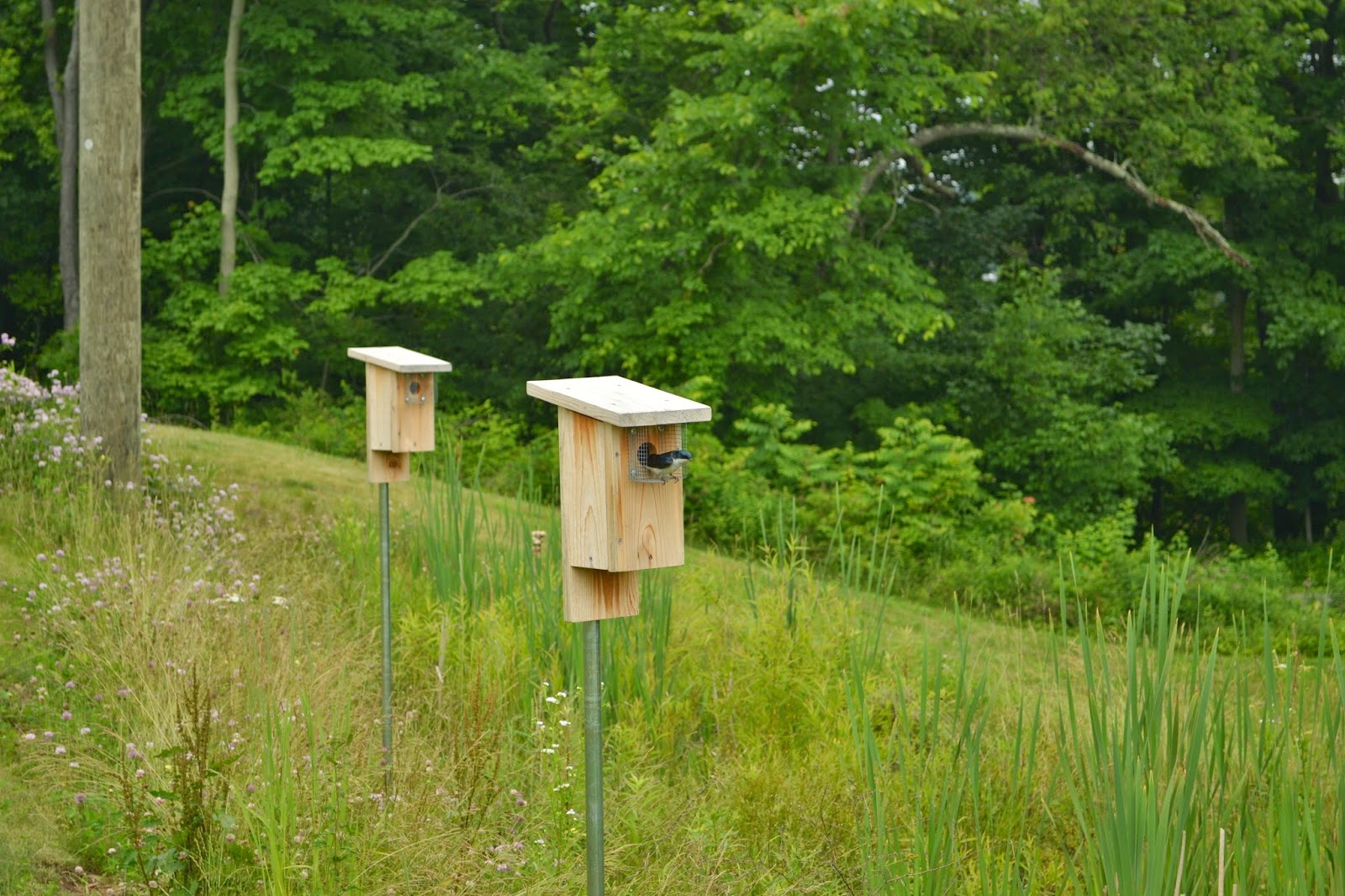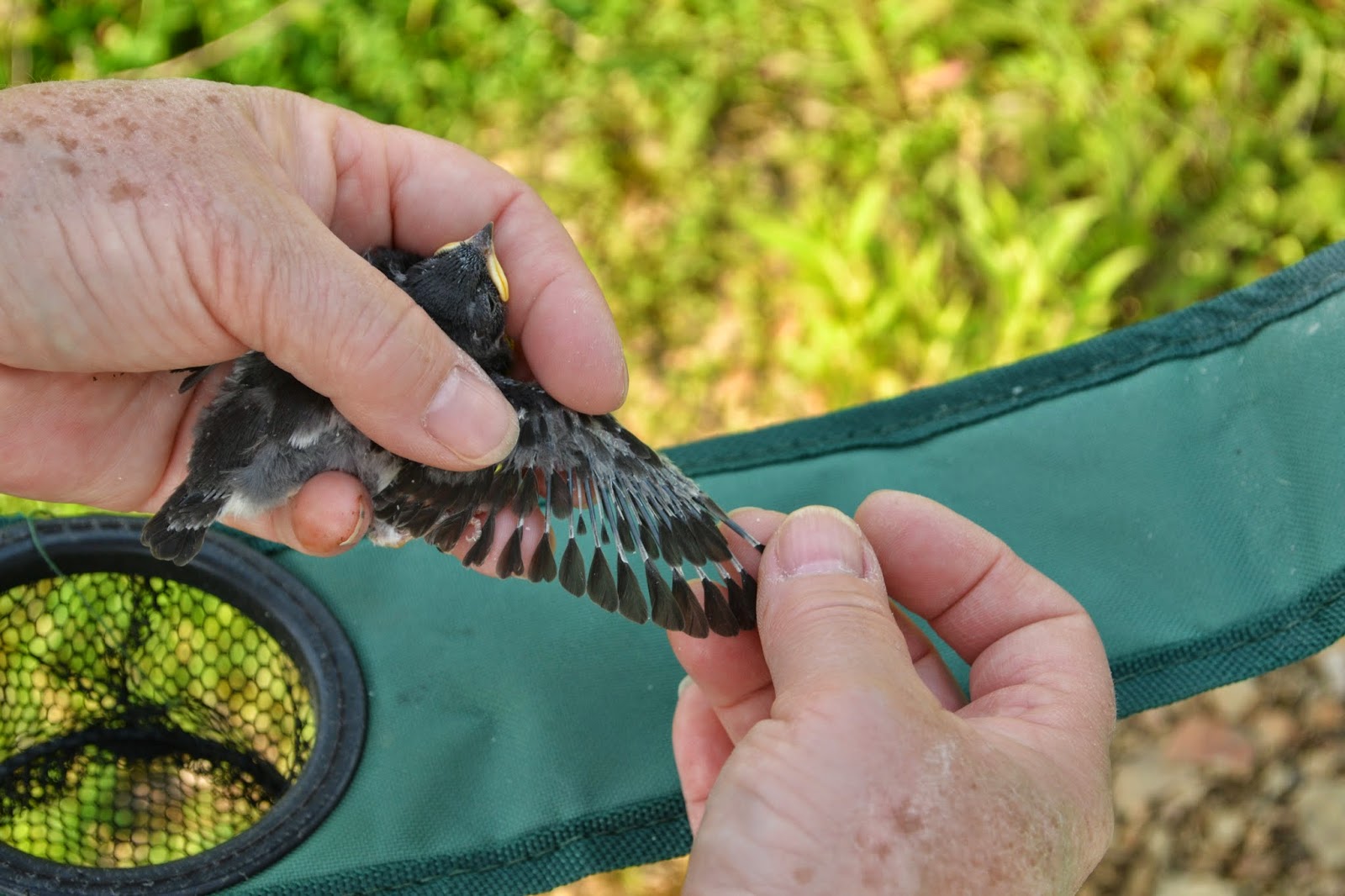Friday, June 27, 2014
New Tenants
Seems like a late time to start, but two new families are taking up residence in these boxes. Both boxes have active nests with eggs. They are both Tree Swallow nests. Ironically, an adult male Eastern Bluebird was feeding a fledgling right near these boxes. Maybe the bluebirds will use the boxes next year!
Monday, June 23, 2014
First Nestlings Have Fledged
The first brood of Tree Swallows from the nestbox trail in the park has fledged. These photos show what an 11 day-old Tree Swallow looks like. At this age, the bird is not yet ready for flight, but another six or days or so is all that was needed.
This nestling seemed alert and healthy.
Getting ready to band the nestling, which involves placing a lightweight aluminum band around its leg, much like us putting on a ring or bracelet. Each band has a unique 9-digit number, this allows researchers to keep track of a particular bird. From this, we can potentially learn about the bird's growth, nesting patterns, migration patterns, lifespan and more.
As you can see, a bird at this age has not yet attained the feather development necessary for flight. This is why we band the nestlings at this age. If we waited longer into their feather development, we would put them at risk of premature fledging, which could jeopardize their survival. Since our first concern is for the bird's welfare, we carefully monitor their development and avoid anything that would jeopardize their health and survival.
After banding these nestlings, all nest checks were done from a distance in order to avoid a disturbance which may have caused the birds to prematurely leave the safety of their nest. Four nestlings were fledged from this nest. These birds are now flying around the ponds near their nestbox. They will not return to the nest now, as they are fully capable of flying well and catching insects as they fly. Perhaps one or more of these birds will return to this area in the future to start their own families. If that happens, you can read about it here.
This nestling seemed alert and healthy.
Getting ready to band the nestling, which involves placing a lightweight aluminum band around its leg, much like us putting on a ring or bracelet. Each band has a unique 9-digit number, this allows researchers to keep track of a particular bird. From this, we can potentially learn about the bird's growth, nesting patterns, migration patterns, lifespan and more.
As you can see, a bird at this age has not yet attained the feather development necessary for flight. This is why we band the nestlings at this age. If we waited longer into their feather development, we would put them at risk of premature fledging, which could jeopardize their survival. Since our first concern is for the bird's welfare, we carefully monitor their development and avoid anything that would jeopardize their health and survival.
After banding these nestlings, all nest checks were done from a distance in order to avoid a disturbance which may have caused the birds to prematurely leave the safety of their nest. Four nestlings were fledged from this nest. These birds are now flying around the ponds near their nestbox. They will not return to the nest now, as they are fully capable of flying well and catching insects as they fly. Perhaps one or more of these birds will return to this area in the future to start their own families. If that happens, you can read about it here.
Sunday, June 22, 2014
When the Monitor is Away, the Birds will Play
Well, I was away for a week and knew that the odds were the nestlings in Box 1 would fledge, which they did. What surprised me was that two new families seem to have moved in to the other boxes in the park. There are two new Tree Swallow nests, with eggs. Another surprise is that the new nests are in paired boxes. The literature would suggest that when boxes are paired, Eastern Bluebirds will take one box and Tree Swallows may take the other. Supposedly, Tree Swallows do not care to nest so close together. I will be monitoring these two boxes carefully to see what develops! An Eastern Bluebird perched nearby and watched as I checked the boxes intended for him!
Today, nestlings from another box were banded. This is Day 12 for them, and the next week or so is a critical time for them to remain undisturbed. If disturbed past today, they may fledge prematurely, putting their survival in jeopardy. This particular box was a bit of a mystery: three Tree Swallows hung around this box quite a bit. One female was confirmed. Initially, six eggs were laid. After a hiatus, two more eggs showed up. Only two eggs hatched, and there are currently two healthy nestlings present. Did one female get chased off by another? Or did something happen to the first female, and is this why only two eggs were hatched? Mysteries to ponder.
If you are in the park, please continue to observe from a distance. If you are lucky, you will get to see the nestlings fledge from their box soon. I will be posting their close-ups soon.
Today, nestlings from another box were banded. This is Day 12 for them, and the next week or so is a critical time for them to remain undisturbed. If disturbed past today, they may fledge prematurely, putting their survival in jeopardy. This particular box was a bit of a mystery: three Tree Swallows hung around this box quite a bit. One female was confirmed. Initially, six eggs were laid. After a hiatus, two more eggs showed up. Only two eggs hatched, and there are currently two healthy nestlings present. Did one female get chased off by another? Or did something happen to the first female, and is this why only two eggs were hatched? Mysteries to ponder.
If you are in the park, please continue to observe from a distance. If you are lucky, you will get to see the nestlings fledge from their box soon. I will be posting their close-ups soon.
Thursday, June 5, 2014
Dive-Bombers
The nestlings are doing well, growing feathers and starting to open their eyes. They are noticeably larger each time I see them. The parents dive-bomb me as I check the nest, and even call in reinforcements. It is not unusual for six or more swallows to dive and snap their beaks as I check their nest. Soon these young birds will leave their nestbox and start exploring the park on their own. Tree Swallows are experts at flying upon leaving the nest, and will be able to catch their own food on the wing. Tree Swallows are insectivores and you will likely notice more of them swooping through the park in the next week or so. Over the course of their nesting, one family can consume up to 300,000 insects. Most of these are caught no more than 40 feet above the ground, which means while you are busy watching your kids play ball in the park, the swallows are busy snapping up the insects which might otherwise bite you. This is one reason it is important to help birds! Tree Swallows migrate south for the winter, some stopping in Florida, some going as far as Central America. Their migration will begin towards the end of summer. For now, enjoy these acrobatic fliers as they reduce the population of pesky insects.
Subscribe to:
Comments (Atom)





